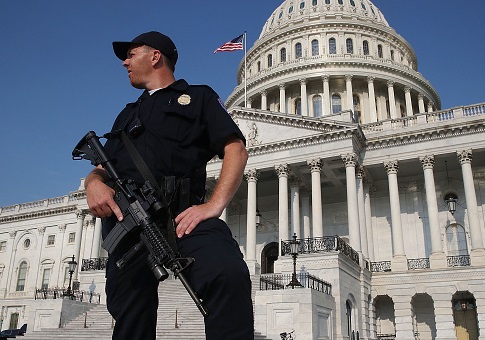In Washington, D.C., most of the people connected to the criminal justice system are black. The prisoners, yes—91 percent in 2014—but also the police officers, guards, and judges. How could a system with an overwhelming number of black administrators produce overwhelming incarceration of black citizens? This is the question James Forman Jr., a professor of law at Yale, seeks to answer in Locking Up Our Own, which documents the role that black voices played in the formation of the modern punishment regime in Washington, D.C., and, by extension, America.
Forman writes in the context of familiar history. In the 1970s, '80s, and '90s, violent crime spiked in America’s urban centers, and heroin, PCP, and crack in turn devastated communities, especially black ones. In response, states and federal governments passed harsh mandatory minimums laws, "militarized" the police, and threw millions into prison. This was just as true in the nation’s capital as elsewhere, and Forman effectively argues that it was driven in large part by Washington’s black citizens.
The author identifies the seeds of black support of tough-on-crime policy in the 1970s. In 1975, D.C.’s failed attempt at marijuana legalization—a white-led effort—was defeated by black opponents who feared the destructive impact heroin was already having on their communities, as well as what some black nationalists identified as the self-improvement-limiting effects of marijuana. Spiking gun crime led to a debate that same year over a possible gun ban which, ultimately, produced black support for early mandatory minimums. And the whole decade saw the emergence of support for making D.C.’s police departments the same color as D.C., with more black officers and chiefs—even though, Forman argues, "many of [the nation’s dozens of black police chiefs] would propel, not constrain, an emerging tough-on-crime environment."
Importantly, these policy stances were thought to fit with black Washingtonians’ political interests. Black leaders would happily side with liberal reformers when it came to expanding social services or improving schools. But they split when the choice was between social reform and safety. As Forman quotes Stokey Carmichael: "You talking about a white college kid joining hands with a black man in the ghetto, that college kid is fighting for the right to wear a beard and smoke pot, and we fighting for our lives."
This concern for safety formed the backbone for black Washingtonians’ response to the crack epidemic, which ripped through D.C. in the '80s. Plagued by violent crime and a spiking murder rate, citizens agreed with the sentiment of prominent black columnist Carl Rowan that insufficiently harsh courts "let the perpetrators of unconscionable violence go free to terrorize minority communities again and again." Initiative 9, a 1982 referendum that raised mandatory minimums for drug crimes, was overwhelmingly supported by black D.C. "In fact," Forman writes, "the only precinct in which the initiative failed to win a majority of votes was in the Palisades, a wealthy, mostly white neighborhood."
Crack violence led also to support for so-called warrior policing, with military-style "operations" like 1986’s Operation Clean Sweep, earning the support of then-mayor Marion Barry and the city’s majority black police force. Operation Ceasefire was rolled out to seize guns in the District through pretext stops of cars, a tactic often criticized as racially discriminatory today. The U.S. Attorney running Ceasefire? Future Obama attorney general Eric Holder.
Forman is an opponent of today’s harsh criminal justice system and does a solid job of arguing that tough-on-crime black leaders were sometimes, even often, misguided. We should not, however, be quick to dismiss the basic correctness of their key point. Alongside other basic black community needs—access to food, healthcare, education—exists the need for law and order. Black leaders’ historical advocacy of this point is sometimes ignored, but as Forman puts it, "a range of black voices agreed ... that safety was a civil rights issue."
Black leaders usually insisted, correctly, that criminal justice has to be situated in a broader view of the condition of black Americans—one in which criminogenic factors like poverty or weak schools are addressed. But just as important, they insisted that no single factor is prior to any other, and that crime is itself criminogenic. To create a prosperous and healthy community, families must not live in fear of crime.
Locking Up Our Own is strongest as a case study of D.C. It works less well when Forman over-generalizes its lessons or is too reliant on heartstring-tugging but too-long anecdotes from his time as a public defender. There are stronger examples of the genre; interested readers should seek out Michael Javen Fortner's Black Silent Majority (Harvard 2015), which documents the role black New Yorkers played in the creation of the Rockefeller drug laws in the 1970s, and which Forman himself cites approvingly.
Still, Locking Up Our Own contributes an important perspective to the 2017 criminal justice discourse. Whether or not one supports the current toughness of America’s punitive regime, it is important to understand its origins not merely as a new form of racial control, but as a product of the legitimate—if, some would argue, misguided—concerns of a country, and specifically of black communities, plagued by problems which called for law enforcement solutions. Keeping those origins in mind is essential to creating a more just and effective system going forward.
